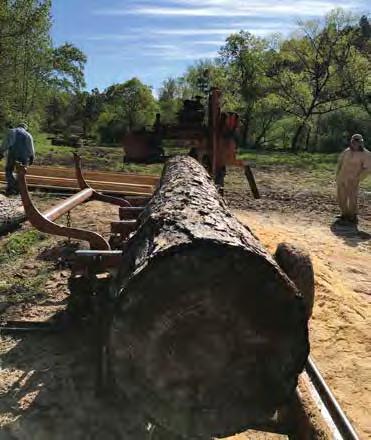
4 minute read
Howle’s Hints
BY JOHN HOWLE
THE HERB FARMER The Wood Master
Advertisement
HOW’S YOUR GARDEN
“Dost thou love life? Then do not squander time, for that is the stuff life is made of.” Ben Franklin Start Cutting Last winter, I cut some large pine trees, which we cut into log lengths ranging from 16 to 20 feet long. Recently, we enlisted the help of our local Wood master, K enny Benefield, for sawing the logs into 1 and 2 inch cuts of lumber for the construction of an extension on SIMPLE TIMES our hay barn. Benefield has been sawmilling logs into lumber for over 20 years, and his Woodmizer sawmill is
The aroma of freshly cut pine logs as they are cut pulled behind a 3/4 ton Ford truck. into planks and beams is a pleasing smell. Once the Using a 22-horsepower, gasoline-powered Kohler wood is cut to the specified thicknesses and stacked for seasoning, the process of sawmilling your choice timber can save you a lot of money over buying the lumber at box stores and lumberyards. In addition, you can ha ve the wood cut to your desired lengths and thickengine, the mill can handle logs up to 40 inches in diameter. Hydraulics power the lift arms to hoist the log on to the cutting platform, and hydraulics also power the mechanism that flips the log for every 90 degree turn until you are left with a large, perfectly square beam. THE CO-OP PANTRY nesses depending on the structure you plan to build. Out of this beam is where you get your lumber cuts.
Kenny Benefield’s son, Charlie Benefield, uses a log peavey to roll the log onto the lift arms of the mill.

Benefield is 81 years old, and he had a heart attack last October and a stroke last November. Today, he only works two to three hours at a time, but he says running the mill gives him something to look forward to and stay active. We had approximately 3,000 board feet from the logs we had milled.
Storage and Preservation
Once the boards have been cut, it’s now time to store them to prevent rot and insect damage. Typically, you can space two concrete blocks at six-foot intervals with a cross plank over the top of each block. Next, stack your first layer of lumber. Here’s where I add a couple of steps. Take a large push broom and remove loose sawdust from the stack of lumber. After that, I spray the lumber down with a product called Tim-bor, which can be ordered online through Amazon.
This is a water-soluble, inorganic borate salt with insecticidal and fungicidal properties to guard against wood-boring pests. Not only does the product prevent fungus and mold from growing, it is useful against termites, powder post beetles, carpenter ants and timber beetles. I’ve also been told that it prevents carpenter bees from creating damage. Once the insect ingests the borate salt, it shuts down their digestive tract.
Once you sweep, spray, flip the lumber and do the same to the other side, it’s time for the next run. Us

This log is ready to be processed with the large band saw of the mill.
ing narrow strips of wood that were left over from the sawmilling scrap pile, la y cross-strips every 5 feet or so for the next layer to be stacked on. These narrow strips allow air to flow through the stacks helping the lumber to dry out and not rot or mold. If the stack is stored outside, you can place cross planks on top of the entire stack and scr ew roofing tin to the top of the stack to


Once Kenny Benefield makes a cut, he walks the cutter back to start position.
keep the rain off. If you are stacking the lumber in a covered shed or barn, this last step won’t be necessary.
Future Uses
In our case, the sawmilled lumber will be used to create an extension on a hay barn, but we ended up with enough lumber to build a small house. If stacked and stored properly, the excess lumber should be good for years to come. If you are building a hay barn or any wooden structure on the farm, typically you can use treated wood for any points contacting the ground. Some people use discarded power poles and some use treated four-by-six post beams for starting from the ground. The sawmilled lumber can be used for beams, rafters, plates, lathing and bracing as well as walls and floors. Sawmilled lumber is considerably cheaper than buying from retailers and the quality is top grade. The prices range around $200-$300 per thousand board feet of lumber and some mill operators may not have a transportable sawmill meaning that you would have to haul the logs to their operation for cutting. If possible, find a mill operator that has a transportable, portable saw mill.
This July, if you find yourself just milling around, pick out some large, choice pine trees that are straight

Kenny Benefield makes the last board cut out of the log.
and free of knots for saw milling. You’ll find plenty of projects that this lumber will be useful for, and it’s a satisfying feeling doing construction projects with timber that comes off your own place.











